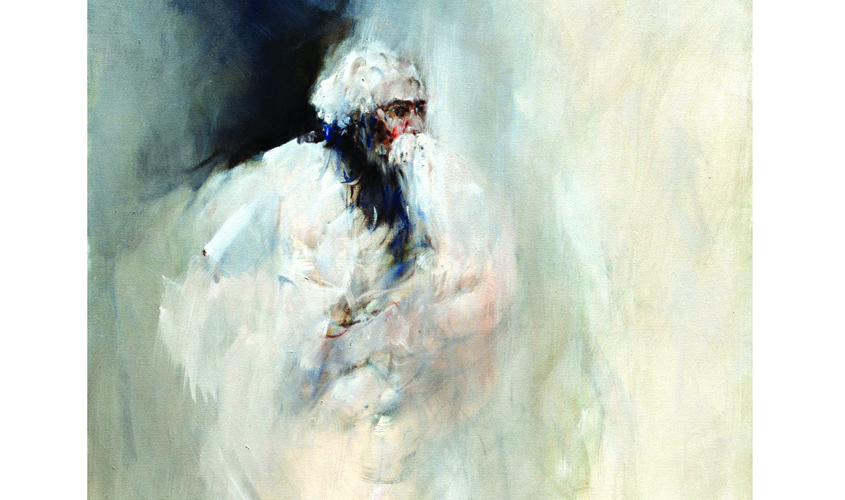One of the most celebrated Bangladeshi artists of contemporary times, Shahabuddin Ahmed recently concluded his art show at Rashtrapati Bhawan. He was invited by the President of India Pranab Mukherjee to be a resident-artist at Rashtrapati Bhawan and also display his select work for public viewing. Titled Shanti, the exhibition comprised 12 large-scale works presented by Ganges Art Gallery, Kolkata. The show was on till 22 February.
67-year-old Shahabuddin, is settled in Paris for nearly four decades now. He is a celebrated international persona and the national pride of Bangladesh. Above all, Shahabuddin is a MuktiJoddha, a “Platoon Commander”, who fought in the liberation war of Bangladesh, when he was 21-years-old, alongside Sheikh Mujibur Rahman, the founding father of Bangladesh. Young Shahabuddin was the first to host the flag of Bangladesh on Dhaka Radio office (that time Pakistan radio) before noon.
India is not very far from his heart either and neither are Gandhiji, Rabindranath Tagore and Mother Teresa. Shahabuddin has also very successfully highlighted through his works, the pathos of war and the struggle of the people of the sub-continent and the freedom movement of India and Bangladesh through recurring portraits of Gandhiji and Bangabandhu Sheikh Mujibur Rahman among other prominent personalities of the sub continent.
Smita Bajoria, Director, Ganges Art Gallery says, “Shahabuddin first exhibited his works with us almost 22 years ago and it has been a very fulfilling journey for both the gallery and the artist. I saw in the art of Shahabuddin a very strong link not only between India and Bangladesh but also a bridge to the western world as Shahabuddin had in the latter part of his education been greatly influenced by European and English painters alike. When the President inaugurated his show in Kolkata, he hoped these works could be shown in Delhi and other parts of the country as well. With this invitation, we are being able to take that first step.”
Writes Gerard Xuriguers, art critic in France talks about Shahabuddin’s work: “Shahabuddin, before settling in Paris, experienced a threatened identity, in Bangladesh that he vigorously liberated in 1971. This period of his life, both dramatic and full of hope, has undoubtedly affected his artistic path and forged his character. However, he did not turn into a militant painter, but simply a painter, a painter that always cared more for painting than for the subject of his painting.”

Shahabuddin Ahmed talks about his art. “The experience of war has guided my path, but contrary to what many believe, I don’t paint war and war is in no way my creed. What I want to depict is the human suffering in defiant postures, borderline situations, in which the individual has to reach his limits. Nor do I choose death as a subject, because deep down, the nature of my interest is rather optimistic. And in the cracked attires of my characters, that some consider to be the reflection of the “freedom fighter” or the athlete, is nothing more than the manifestation of the state of one’s suffering.”
Shahabuddin Ahmed, born on 11 September 1950, in Dhaka and studied at the Academy of Fine arts in Dhaka before obtaining a scholarship to study at the Ecole Superieure des Beaux-Arts de Paris. He has shown his works extensively around the globe. In 1992, he was one of the Fifty Master Painters of Contemporary Arts, an award bestowed on him at the Olympiad of Arts, Barcelona. He also received the Shadhinota Padak in 2000 (The Independence Day Award for his contribution during the Independence War of Bangladesh in 1971) and the Ordre des Arts et des Lettres in 2014 for his contribution to Art in France and globally.
His creations are in collection of the Museum of Bourg-en-Bresse in France, the National Museum of Bulgaria, the Olympic Museum of Lausanne in Switzerland, the Seoul Olympic Museum in Republic of South-Korea, the National Museum of Taiwan, Bangladesh National Museum and many other galleries and private collections.
- Advertisement -

